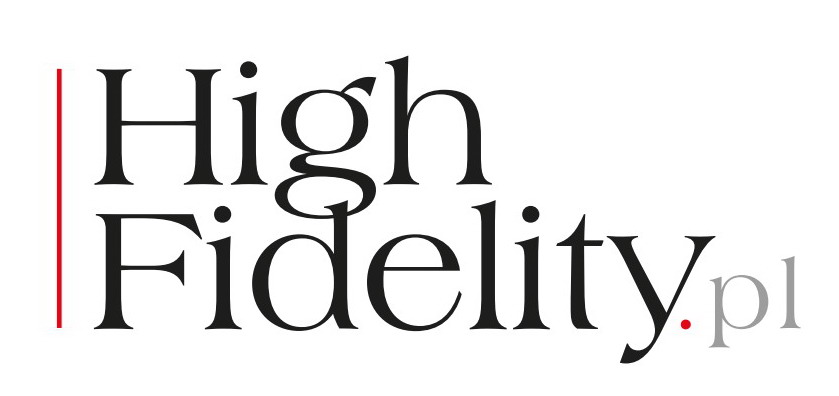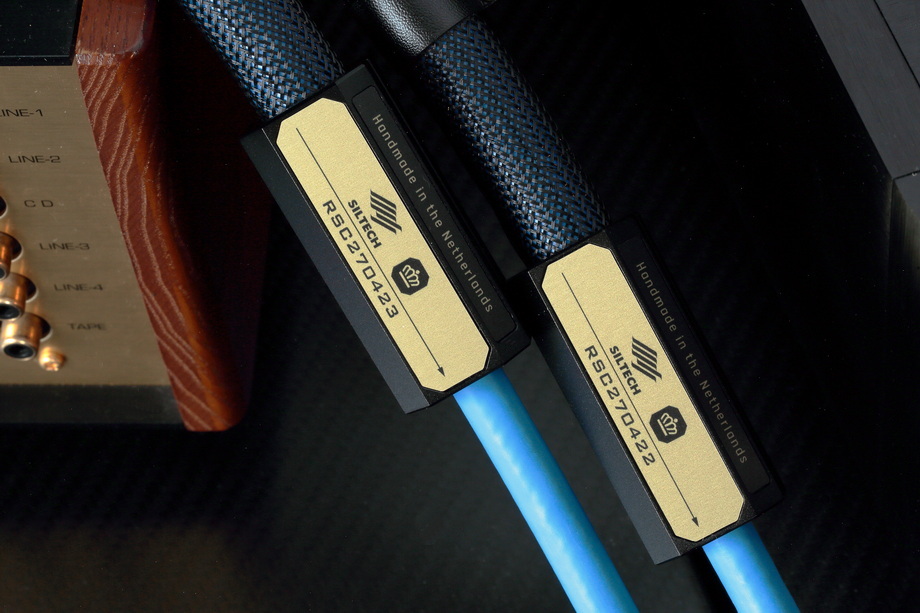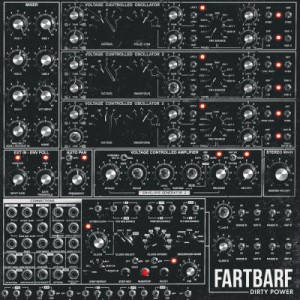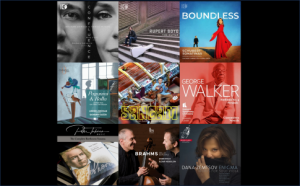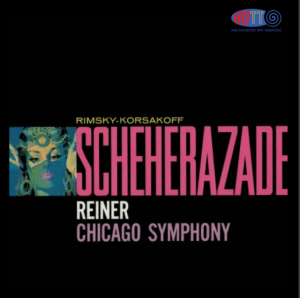When the heads of Warner's headquarters learned of the sale of Polish Recordings, then—as Bartek Chaciński writes in the article Marka dużej wagi—they asked only whether it is a company that has Krzysztof Komeda's Astigmatic in their portfolio. This album is still among the best jazz recordings—not only in Poland but all over the world. Released with number 5 in the Polish Jazz series perfectly endured the passage of time, which can not be said for all 76 albums included in this series.

The series was an idea of the composer and artistic director of the Polish Recordings, Ryszard Sielicki, but it actually realized for years by musicologist Andrzej Karpinski. Covers were designed by the best of the best - Rosław Szaybo and Marek Karewicz. The series was preceded by the Go Right album by Andrzej Kurylewicz quintet, which was unofficially called "vol. 0", and was being officially released since 1963, when the album with traditional jazz music by Warsaw Stompers, New Orleans Stompers, vol. 1 was released. The series ended in 1989, when they released the last album—Lonesome Dancer by Lora Szafran. PJ was obviously not the only jazz series released in Poland. Different albums were released under the PolJazz name by the Polish Jazz Association, and since the late 1970's Polish jazz was also released on Helicon Records discs, founded by the International Federation of Jazz. However, it was the most prestigious one.
Most PJ albums were reissued, first on LP, and after 1989 some were also reissued on CD, but not all of these new issues offered good quality. Therefore, the decision of Warner Music Poland to release ALL Polish Jazz series, both on Compact Discs and Long Plays (180g) is highly appreciated. Even more so as a large part of the titles released as part of this series today is not particularly attractive (so expected sales might not be too big). As Paweł Brodowski says, the editor-in-chief of the Jazz Forum magazine, an expert on jazz, the main editor of the series relaunched by the new owner, it includes albums of exceptional artists such as: Namysłowski, Komeda, Kurylewicz Trzaskowski, Wroblewski, with traditional, innovative and experimental jazz. But many of them are the result of knowing right people or were recorded (almost) by coincident. And yet... "It is difficult to indicate equally important, valuable music series in our part of Europe" - says Brodowski cited above, and it is hard to argue with that. All the more respect to Warner for this decision.
In early April the first group of six Polish Jazz albums remastered by Jack Gawłowski JG Master Lab were released. It is the same man who was responsible for, among others, Niemen's, Maanam's etc. remasters, that we wrote about in the our May issue (see HERE). Pawel Brodowski was responsible for the merits of the reissues and he came up with the idea about in what order should these albums be released. The simplest method would be to issue them one after the other, but it would probably not be particularly attractive for music lovers and probably would not guarantee financial success—these are two sides of the same coin. So he came up with the idea of releasing albums in groups of six and each such group will include traditional, experimental, vocal etc. jazz in such a way that each group will also include recordings from different periods. By the end of this year dozens of titles will be released.
The first group includes following albums:
- ANDRZEJ KURYLEWICZ, Go Right, Polskie Nagrania 1963/ Warner Music Poland 2016 | Vol. 0
- KRZYSZTOF KOMEDA QUINTET, Astigmatic, Polskie Nagrania 1965/Warner Music Poland 2016 | Vol. 5
- NOVI SINGERS, Bossa Nova, Polskie Nagrania 1967/ Warner Music Poland 2016 | Vol. 13
- TOMASZ STAŃKO, TOMASZ SZUKALSKI, EDVARD VESALA, PETER WARREN TWET, Polskie Nagrania 1974/ Warner Music Poland 2016 | Vol. 39
- EXTRA BALL, Birthday, Polskie Nagrania 1976/ Warner Music Poland 2016 | Vol. 48
- EWA BEM WITH SWING SESSION, Be a Man, Polskie Nagrania 1981/ Warner Music Poland 2016 | Vol. 65
Since tis is the first batch of new remasters, I feel I owe Readers an introduction and I should also outline the context, which significantly extends this test. The next parts will be much shorter. This article has been divided into two parts: Part 1. titled: Polish Jazz—editions and Part 2: Remaster 2016—sound quality. You can start from the first one, or you from the second, read them separately or together—I leave the choice to you. We would like it to be a solid basis for the remaining parts of this cycle.
PART 1
Polish Jazz – editions
Given the importance of a large part of the albums issued with PJ logo, as well as their popularity, a small number of reissues come as a surprise. Most of them concern the Komeda's ASTIGMATIC album and there is something to boast about: there are seven Polish editions on vinyl (plus one Czech and one German release) and nine editions on the CD. No other item from the catalog of Polish Recordings come even close to these numbers. Usually there are two, rarely three, LP releases and one, or even no CD release. The problem is that in fact they never managed to reissue all the items of Polish Jazz series. In the next part of Polish Jazz Forever I'll write about vinyl editions, but this time I would like to focus on digital editions. One must know that, although the CD and LP versions are released simultaneously, the new remaster was prepared in the digital domain for the Compact Disc release.
Reissue 1989
The first attempt took place already in 1989, so soon after the Polish Recordings began selling CDs. Fifteen albums were released labeled "Polish Jazz," with recordings of Komeda, Trzaskowski, Ptaszyn Wroblewski, Novi Singers and so on. But this is not a full-fledged re-release, because the discs contained a variety of tracks taken from different albums of the artist, although they used only albums released as part of PJ series. In the case of Komeda they resorted to full ASTIGMATIC album, adding eight additional tracks to it. Recordings were transferred to the digital domain from analog tapes, but it is unclear whether these were the master tapes or copies, and if these were "master-tape" then of which generation. Covers used for all discs were identical and today they could only arouse nostalgia—for many years they were considered to be extremely ugly.
Reissue 2004: "so called Anex"
Polish Recordings performed another attempt only in 2004. This was the first time when the Polish Jazz albums were reissued with their original covers. Unfortunately only 16 albums were released and the project was abandoned. Among the selected titles there were such albums as: Go Right by Kurylewicz, Astigmatic by Krzysztof Komeda Quintet, TWET by Tomasz Stanko, Winobranie by Zbigniew Namysłowski, Unit by Adam Makowicz, Scant by Andrzej Trzaskowski Sextet and Modern Pentathlon by Laboratory.
Discs were issued in digipak boxes, with the first opened page that was a copy of an analogue edition—on the front page there was a cover, and the other (internal) a back side of the cover. The CDs were imitations of LP albums, with a vinyl-like label in the middle and with a black edge. The label had nothing to do with the original issue, though. The cover artwork was pretty good. Under the clear plastic inside all the PJ titles were listed, including Kurylewicz Go Right, but without a number. It is worth noting that for the first time the publisher officially included Andrzej Kurylewicz and his trio's album to the canon, although originally it was released without PJ logo and a series number. It is only corrected by Warner Music Poland, that at its remaster of 2016 gives this album a number, "vol. 0".
Sound quality was also better—Ms Joanna Szczepańska and Mr Wojciech Marzec, both representing the Mastering Studio of Polish Recordings, prepared a new mastering from the original master tapes in 24-bit resolution. Mr Jarek Nowak was responsible for scanning and editing of the artwork. The problem with this issue is that after some time digipak began to bend, as if gluing of paper covers and plastic interior wasn't properly done. On the discs and the back cover a logo was applied with a note inside a frame, ie. one that was used since 1979.
Reissue 2005: "Polskie Radio poleca"
A year later another, by far the most beautiful, reissue of selected PJ titles is released—unfortunately, only twelve of them. Bartek Chaciński wrote recently in the Polityka that this issue was on the verge of legality, though still the "right" side of things; as the most of the releases of that time were. The series included: Laboratory, Extra Ball, Tomasz Stanko and Zbigniew Namysłowski albums.
These albums were issued by the Polish Radio in very nice digipaks. In their cover they cut out a "window" (hence it is known as the "windowed" release), in which we could see a reduced cover. One could pull this insert out and read an essay by Józef Balcerzak, the editor of the Jazz magazine referring to the particular artist. Printing using colors white, red and black and spot varnish was of high quality, which ensured a very nice aesthetics effect for these releases. CDs did not pretend vinyl records and had a uniform, white print on them. The albums could be purchased separately or together, in a tasteful box—that's a very rare version.
It is interesting that just a year after the previous remaster they decided to make a new one. It was prepared by Ms Katarzyna Gleinert, whom a year later I interviewed for the "Audio" magazine. As she told me, she had at her disposal the original master tapes that she transferred to a digital domain in 24-bit resolution, with a 44.1 kHz sampling rate. Only then a noise reduction was performed using CEDAR noise cancelers and correct the defects of the tapes. She noted a poor condition of some tapes. The body responsible for the whole process was Polish Recordings Mastering Studio. This edition repeated only one title Scant by Andrzej Trzaskowski Sextet, which in total gave us 28 titles already available on the Polish Jazz CDs.
Remaster 2006-2007: "Polish Jazz Deluxe"
Promotional materials for Polish Jazz Deluxe series reads:
A starting point is an iconic collection of analog records issued under the Polish Jazz Series name, which since the early 1960s documented the achievements of Polish jazz artists. Its originators were Ryszard Sielicki (then artistic director of the Polish Recordings) and Andrzej Karpinski (the most famous editor of the company). The latter piloted the series until late 1980s, editing a total of 76 albums. The albums of the Polish Jazz series, especially in the 1960s, were an objective chronicle of Polish jazz. Without favoring individual styles of jazz it played first and foremost an important role of a historical document.
source: ONET.pl
36 titles were released, of which only 21 came from the catalog of Polish Jazz. For the first time it was decided to expand the canon and to complement it with a series of titles that for some reason were not included in it before. And these were such great albums as: Easy by Wojciech Karolak, Bemowe frazy by Bemibem, or The Killers by Karolak / Szukalski / Bartkowski. CDs were released in digipak resembling a re-release of 2004, but instead of two elements it featured three. Again a person responsible for the remaster was Ms Karolina Gleinert.
The graphic design is a "work" of L. Carnelli (MEMO). Word 'work' is placed in quotes on purpose, because the printing of this series is widely considered the least successful one. The small reproductions of covers with a record in the background or in case of Time Killers of a tape did not, and after all these years still do not make a good impression. It helped that on the third part of a digipak a reproduction of the cover was placed, but the not so favorable impression remained. The disc itself was again a reference to the vinyl record with a colored label in the middle.
Reissue 2016: Warner Music Poland
Anna Zając on behalf of Warner Music Poland is an executive producer of the new re-issue. I do not know who chose these particular people to do particular tasks, but I would like to bow to all of them deeply, because the albums were issued with great care obviously taken in all aspects: editorial, printing and sonic too (I'll get back to it in a moment). Anyone who remembers the three previous attempts of Polish Jazz CD releases will surely highly appreciate the latest one.
The release has the form of a three-part digipak with a booklet and thick covers. For the first time an exact reproduction of the album's is used for a CD release—on the previous ones cover reproductions were either too small (Polish Jazz Deluxe), or had wrong proportions because digipak's shape is rectangle, not square. Printing has a pleasant matte finish, and a spot varnish was applied on covers, making them stand out even more. The space left on the first page of digipak was used to apply a Polish Jazz logo and a following number in the series. I mentioned already that o Right finally received an official number, "vol. 0 ", but obviously only on the vinyl edition—on the CD for some reason it is missing, shame.
Person responsible for the graphical concept of the series is Łukasz Hernik, and for photo editing Przemysław Pomarański. I bow to them deeply. Typography, layout, choice of colors—everything is perfect and I feel jealous that I did not come up with something like that... Lets add to this a little rooster on the front page and nicely matched printing on the discs and you'll have a complete idea about how it looks like. Inside, you get a beautifully restored photos of artists and an essay—for each album someone else wrote one. Introduction to Go Right was written by Michał Wilczyński, head of GAD Records label. For the first time a person from the outside is responsible for the remastering of the whole material—it's Jacek Gawłowski of JG Master Lab Studio.
Others
Karolak/Szukalski/Bartkowski, Time Killers, Milo Records, "Polish Jazz Masters vol. 3" (2003)
And finally I would just like to indicate that in addition to Polish Recordings reissues also Power Bro company released its own Polish Jazz reissues, although with altered cover art. Milo Kurtis (via his Milo Records) released several albums in 2003 as part of the Polish Jazz Masters series (eg Time Killers Karolak / Szukalski / Bartkowski). Reissues of Laboratory albums such as: Modern Pentathlon (vol. 49), and Quasimodo (vol. 58) were included in the box titled Anthology 1971-1988. All recordings released by Metal Mind Production in 2006 ("digital remaster 24-bit"); these featured "carboard sleeve" covers. These featured additional tracks from the period, but the downside was their decision to edit out the logo of Polish Recordings from the covers. In 2008 the same label released several titles from the Tomasz Stańko Tomasz Stanko in a the box named 1970/1976/1984/1986/1988.
Laboratorium,Modern Pentathlon (vol. 49) and Quasimodo (vol. 58), in: Antologia 1971-1988. Nagrania wszystkie, Metal Mind Production (2006)
On the other hand, already mentioned, Marek Wilczynski of GAD Records released two titles: Jerzy Milian Trio Baazaar (vol. 17, 2015) and Krzysztof Sadowski and His Group Three Thousands Points (vol. 47, 2015). The Jerzy Milian album was released not only on CD, but also on vinyl with black and color version. The digital releases featured classic jewelcase boxes (or so-called. "plastics"). You can find a review of both versions in issue no. 129 of High Fidelity of January 16th 2015. (see HERE).
Jerzy Milian Trio Baazaar (vol. 17, 2015) and Krzysztof Sadowski and His Group Three Thousands Points (vol. 47, 2015), GAD Records
However, this was a single publication and not the whole series. So a longer series was welcome in even more enthusiastic way. The "Polish Radio Jazz Archives" of Polish Radio, launched on April 21st included three titles:
Stan Getz / Andrzej Trzaskowski Trio (vol. 01), Don Ellis / Wojciech Karolak Trio (vol. 2), and Jazz Jamboree'62 (vol. 3). It was described as: These recordings are an amazing document of a collaboration between the best Polish jazz musicians and international stars. Concerts have been recorded by accident and due to determination. Although some of the tracks were already known, such as saxophonist Stan Getz's, who agreed to release five tracks. These were released on the Polish Recordings mini LP Stan Getz in Poland. They were re-issued arousing the interest of fans around the world. Now we get a big dose of great music that, in addition to its documentary nature, shows artistry and class of Polish musicians.
source: Polityce.pl
PART 2.
Remaster 2016: sound
Kurylewicz Quintet
GO RIGHT | vol. 0
Polskie Nagrania "Muza" XL 0186/Warner Music Poland 4648802
1963/2016
In the first part of the PJ remasters I could not miss the true treasure of Polish jazz music, ie. the Astigmatic album by Krzysztof Komeda Quintet. I'll get to it in a moment, but first I have to admit, that I personally enjoyed listening to this Polish Jazz album most. I also believe that this is one of the best Polish recordings ever made. What's more—with this recording the mastery of Jack Gawłowski is fully expressed. On what do I base this opinion? Please note captured by producers, and carefully reconstructed by Jacek (that's how I understand his role) space. It reminded me of the best Prestige, Contemporary Records, or Blue Note's recordings. Imaging is full-bodied, dense, natural. The instruments are placed close to the microphones but can "hear" other instruments too (the so-called "leaks"). I have not heard anything like in any Polish recordings for a long time. Even more so as I know the mono release of this album and for a long time I believed that there was no other version (stereo version is not available on the second-hand market).
Another thing is the timbre. Jacek when I talked to him, which I shared with you writing about Niemen's, or Maanam's remasters, said his goal was to return to natural sounds, rather than an attempt to get closer to the first edition, which—he said—was most often a result of compromise. Therefore, Go Right features a dense timbre, saturated and filled. A double bass sound really great which on most Polish albums sounds lifeless, empty. Here it offers a very convincing timbre, volume, and large "box".
The cymbals are saturated, but do not go too far up, what must a result of microphones, tape recorders and the type of tape that were used, as well as the age of the recording itself - 53 years passed from the moment this music was actually recorded! Let's add excellent dynamics to all that, and it turns out that Vol. 0 in the Polish Jazz series, thanks to Jacek Gawłowski, set the bar incredibly high. The Compact Disc version is the best version of this album, I know. In secret I can tell you that I liked it more than the original analog one—but let's keep it between us ...
Sound quality: REFERENCE
Award: BIG RED Button
Krzysztof Komeda Quintet
ASTIGMATIC | vol. 5
Polskie Nagrania "Muza" XL 0298 | SXL0298/Warner Music Poland 4648860
1965/2016
The ASTIGMATIC album is one of the most frequently re-issued titles of Polish jazz. So there is a lot one can choose from when it comes to comparison. Originally it was published as mono and stereo LP. On CD it is known only by stereo version. For the purpose of this comparison I chose the 2011 re-release remastered by Ms Carolina Gleinert, because until now it was the last one, and secondly because it is a really good re-release (I am working on an article comparing all editions of Astigmatic). Ms Karolina decided on it a little deeper compression, so the sound is bigger and closer to the listener, and therefore very catchy. Her second, equally important choice was a strong compensation of bass (an emphasis of lower end) that added more seriousness and depth to the music.
Perhaps that's why the 2016 version by Jacek Gawłowski seem more dry to me. It is quieter by about 1-1.5 dB, so you have to compensate for the difference with volume knob. Then you will realize that the new version is much more dynamic and more multidimensional. I respect the work of Ms Gleinert, I understand what she did, but I also have to say that the new version—largely thanks incomparably better equipment Jacek has at his disposa—reminded me more of the first vinyl edition of the album. This single fact alone doesn't have to make this version better—see Go Right which in Jacek's version is even better than the original—but in the particular case of Astigmaic the first vinyl release still sets the bar.
The new remaster sound more like live music and not studio recording. And the older versions sound just like that, like studio recording—in a sense that the instruments are close to us, playing very directly and for example the double bass and bass drum are presented in a distinct, powerful way, which we perceive as a "presence". The problem of such type of presentation is the disappearance of the air between musicians and sort of dominance of the mid-bass. This translates to a large volume of sound, but only on a small loudspeakers that do not reproduce lower bass. When played using Harbeth M40.1 with their 30-cm woofer that was too much of it.
Having said that I have to add that this is not the best recording in itself. Comparing with the later recordings of Polish Jazz, especially after vol. 15 it appears to be excellent, but listened after Kurylewicz leaves listener unsatisfied, which is caused by a clear separation of instruments, upon which a reverb was later imposed. Their sound is also not so rich and full, it is not so saturated with harmonics. But I'm not going to complain, after all—the sound of the new version of ASTIGMATIC is convincing, we have a lot of air in it, and high dynamics too. The colors are set so that the whole presentation is coherent, we do not focus attention on something just because it is louder. This is by far the best digital version of this album I know.
Differences between covers of 2004 (below) and 2016 (above) releases
And finally: it is not most important, but it must be said that the album cover is not the exact depiction of the original release, but a revised version of the digital 2011 reissue. The vertical line separating the logo and title of the album was on the original cover shifted towards the title and artist, as if by mistake. In 2011 edition it was adjusted, leaving the same space on both sides—the cover of 2016 issue looks the same.
Sound quality: 9/10
Award: RED Fingerprint
Novi Singers
BOSSA NOVA | vol. 13
Polskie Nagrania "Muza" XL 0415 | SXL 0415/Warner Music Poland 4648858
1967/2016
The Novi Singers album is not the best recorded album in the series of Polish Jazz, even though it belongs to the so-called "golden" group of the first, the most sought after releases. I compared the new remaster to the original analog release and 2004 CD. The latter sounds more powerful and is some 2-3 dB louder. This shows the depth of compression that was applied to it. The use of such a large compression gives certain advantages, such as bringing performers closer to listener, better separation of instruments' bodies and increased tangibility. In 2004 remaster there must be quite significant emphasis in the treble because the percussion cymbals can be heard as if the microphone was placed very close during recording.
The new remaster presents everything from a distance, with a much more air. Yes, directness disappears, but the harmonic relations between voices appears, also original reverb can be heard more distinctly. The vocals are not as clearly separated by highlighting their bodies, as in the 2004 version, but are more like what I know from vinyl. They sound like an ensemble, not a group of soloists. The treble is much more resolving, percussion cymbals are better differentiated, also upper part of vocals sounds nicer. Sure, it's still not some super-audiophile quality recording—it's is simply not particularly well made recording from technical point of view. There is no distinct panorama, because the producers set up vocalists close and didn't give them distinct "bodies". The new remaster helps to restore naturalness by leaving more air and more space to breathe around the instruments, as well as by better differentiation of their timbre.
I think that this album did not 'age' well, neither musically nor sonically. Jacek Gawłowski's version, the new remaster, gives one the opportunity to listen to it comfortably, with the air, the space without emphasis in the upper midrange or treble. But the older version also has something to it, because the emphasized lower part of the range vocals have a greater volume and are more present. After all this is one of these items from the catalog of Polish Jazz, which belong to the “chronicle" group and not to the "best of..."
Let me finish with an editorial trifle—the vocal ensemble NOVI's name is an abbreviation of: "New Original Vocal Instruments". For some discs they used the NOVI name, and sometimes, for example, on Torpedo, there is Novi Singers. The original LP edition of Bossa Nova was marked with an abbreviated name NOVI, still on the crest of a new remaster its full name: NOVI Singers is given.
Sound quality: 6-7/10
Tomasz Stańko
TWET | vol. 39
Polskie Nagrania "Muza" SX 1138/Warner Music Poland 4648855
1974/2016
TWET years later still sound pretty good and still impresses with music quality. The latter is still, like eg. Music of The Art Ensamble of Chicago, exciting and still is avant-garde. It's another album, on which much less compression was used for the new version, than the previous digital edition, because it is quieter by about 2-3 dB. At the earlier release they added bass and treble, but that's not what I wanted to talk about. I think it all starts to create some sort of pattern that can be seen in the new remasters.
Sound of TWET is very resolving, differentiated and has great saturation depth. An older version, and even the original analog seem to be a bit more “empty". While the 2004 Compact Disc release is louder and therefore more 'showy', its sound is more "coarse" and therefore simpler. The A.D. 2016 version has all elements synchronized in a better way, which in turn resembles the original analog version. Music has a flow, it flows and takes listener with it. You can, of course, point to various elements of hi-fi, which are responsible for it, but we should stop at this: the resolution, dynamics, taste, are the elements that make the new remaster shines. It's a must-have.
For comparison – a 2004 version disc
And a word on the edition itself - on the cover of 2004 logo was applied, in which the catalog number reads: "SXL 1138". In fact, since 1971 (Ultima Thule site speaks of 1973) Polish Recordings albums appeared with catalog numbers that begin with the letters SX and that's the only edition of TWET that I know. And such correct logo was used on the cover of the new remaster.
Sound quality: 8-9/10
Extra Ball
BIRTHDAY | vol. 48
Polskie Nagrania "Muza" SX 1414/Warner Music Poland 4648853
1976/2016
Birthday is one of those Jarek Smetana's recordings I always liked her and still occasionally listen to it. Although in 1976, when it was released, it was not especially revealing, one can hear a lot of power in this music and strong personality of the leader. Sound quality belongs to a group in the "middle" between the less successful projects, such as Bossa Nova and better one as Astigmatic. It lacks proper midrange richness, strong top and bass. And dynamics could be better too.
Jacek Gawłowski extracted some color of it. If there is no top and bottom, there is no use to pretend that these are there, same goes for dynamics. The album sounds best on good quality system where there is nothing to prove or emphasize; on systems of lesser quality it might sound too "flat". A good layout of the instruments in space is worth mentioning, which is especially audible with Jacek's remaster. The front of the stage is most important here, and we don't enter too deep into the stage. Differentiation of colors and lack of constraints set by the imperfection of technology are on the upside.
This new remaster, I say this with some reservation and I wish that it is understood this way, sounds very "analogue" in the sense that is usually used for a vinyl record. Sound is soft, saturated and smooth. This is the best digital version of these recordings, I know.
Sound quality: 7/10
Ewa Bem with Swing Session
BE A MAN | vol. 65
Polskie Nagrania "Muza" SX 2365/Warner Music Poland 4648851
1981/2016
The Be a Man album has two faces, cause by the choice of material. The A side of the original analogue edition included English-language jazz standards arranged by Henryk Majewski, the B side included Polish songs including Be a man, with the lyrics written by late Maria Czubaszek and beautiful Good morning, Mr. Blues by Jerzy Wasowski.
It just so happens that the album is devided into to part also by the way sound was produced for them. Nothing is known about the session in which it was recorded, but one can hear that both sides of the vinyl sound differently. Jacek's remaster 'preserved' these differences really well, he did not try to adjust anything. 1980s for music, also Polish one, when it comes to sound quality was a really dark period. The Ewa Bem's album is not all bad in this respect, but you can hear all the ills of a new way of sound production and deficiencies in studio's equipment. Let me add that almost all the reissues of older albums appearing in the 1980s with a yellow label in the middle sound much worse than their previous releases, primarily due to the lower quality vinyl. And so the first editions of the records released in these years do not offer particular sound quality.
The sound is quite bright and not particularly three-dimensional. I do not know if noise correction was used, but it sound a bit as it was. Vocal on the A-side is more piercing and less rich with clearly underlined upper-mid. Drums are not really present with subdued, matte cymbals. In this respect, side B is much better because it is more open, less suppressed, and the vocal is richer has better tonal balance.
The new digital version does not bring any breakthrough, but it is still the best version, regardless of the medium, which is currently on the market. There's a fluidity, brevity and coherency. It might sound as not much but trust me, that's a lot. It is worth to have it primarily because of the music—a new remaster will allow us to enjoy it in a nicer way than before.
A comparison of logotypes: original vinyl issue of 1981 and a new remaster
And a word about the logotype—the new remaster was marked with a wrong logo. At the turn of the 1970s and 1980s they began to use a rectangular logo with a note inscribed in a circle and the words "Polish Recordings" above it, and "Muza" underneath. It is with this logo the Be a Man was originally released, and here they used an earlier version of the logo, from the pre-1979 period.
Sound quality: 6/10
Summary
I think it can be seen what type of modification is brought by the new remaster and the direction which Jacek Gawłowski took. It seems that he minimized the intervention, but did not withdraw completely and where it was necessary he did add some things. The new versions are much more resolving, offer more dynamics and have better captured tonal balance. Older versions, especially those prepared by Ms Caroline Gleinert, are richer, with an emphasis in the bass area, which makes them also sound attractive. And yet the 2016 remaster is simply unrivaled. The most important elements of this whole process is the analog-to-digital conversion and Jacek using Apogee converters did it perfectly. This new version of Polish jazz in the digital edition really, really speaks to me—thanks a lot!
I would like to end now the first meeting with the Polish Jazz 2016 REMASTER. The next meeting will be devoted to comparison between vinyl editions and perhaps another six digital ones. It will also include some general conclusions and my wishes for the special editions PJ (imagined by myself).
Polish Jazz Forever
REMASTER 2016
vol. 0 | vol. 5 | vol. 13 | vol. 39 | vol. 65
Polskie Nagrania
1, Osmańska 11
02-823 Warszawa
POLAND
Text: Wojciech Pacuła
Images: Wojciech Pacuła | Warner Music Poland
Translation: Marek Dyba


































